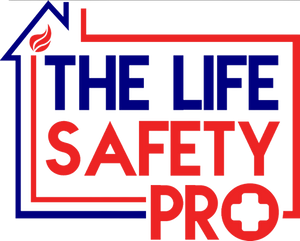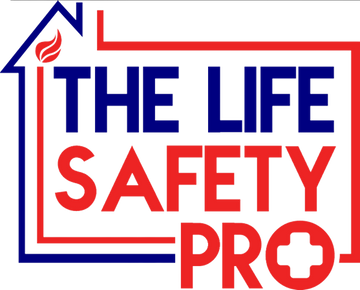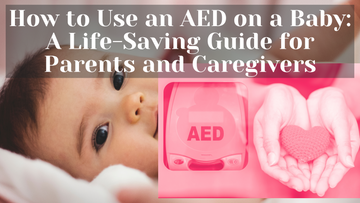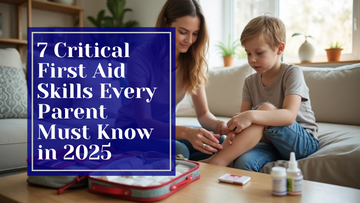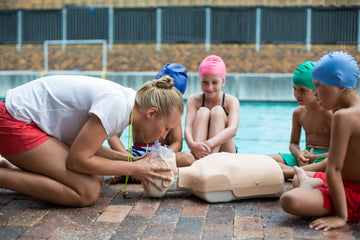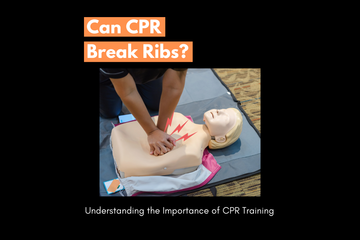Child CPR Hand Placement: A Guide for the Safety-Conscious Parent
by Jeremy Manke on Jan 01, 2024
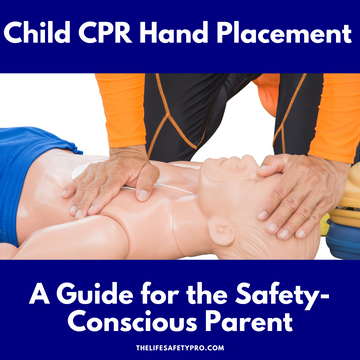
Child CPR Hand Placement: A Guide for the Safety-Conscious Parent
Today, I would like to talk about an essential topic for every parent - Child CPR. Knowing how to perform CPR on young children and using the proper hand placement is not just a skill; it's a Superhero power that can save lives.
The Ideal Hand Placement for Child CPR (Age 1 to the Onset of Puberty)
Place your hands on the center of the child's chest, across from the nipple line. You will use the heel of the hand to push on the center of the chest.
If you are interested in learning more about how to perform CPR please continue to read below. If you need information on the Proper Hand Placement for Infant CPR (Birth to Age 1) Click Here for that article.
The Need for Child CPR
The Importance of CPR or Cardiopulmonary Resuscitation, cannot be underestimated. It's a lifesaving technique used when the child's heart stops. This is an emergency situation that can have various causes such as suffocation, drowning, electrical shock, or a congenital heart defect.
Immediate Actions
1. Try and wake the child up: Use your hands to tap on the child's shoulder to see if they wake up or show any obvious signs of life.
2. If No signs of Life Call 911 Immediately
Calling 911

If you have never called for Emergency Help before it can be scary. Realize that the dispatchers are trained to help and will walk you through the steps of CPR. The dispatchers will ask various things including:
If you are alone and do not have quick access to a cell phone or landline, according to the American Heart Association Guidelines, you should perform 2 minutes of CPR before going to get help. This mainly has to do with the fact that most children in cardiac arrest are there because of a respiratory problem that led to their heart-stopping. If we perform 2 minutes of high-quality chest compressions and rescue breathing it can drastically improve survival rates.
- Your Name, Phone Number, and Address of the Emergency: This is important should you become disconnected and ensure that Medical Services arrive promptly at the correct address.
- Information About the Problem: The Age of the Child, any injuries or illness the child is experiencing.
- The Dispatchers will then walk you through the steps needed for CPR until Emergency Medical Services Arrive.
One thing to remember is to stay on the phone with the 911 dispatchers. They are there to help. Not only are they helping you but they are also helping the Emergency Responders by providing them with the updated information so they will be best prepared to help as soon as they arrive.
Recognize the life-threatening Emergency
Look for obvious signs of life. Including Coughing, Normal breathing where you see chest rises, and Movement of the child, could see wiggling fingers and toes or opening their eyes. This should be done for at least 5 seconds and no more than 10 seconds. After 10 seconds, if you see no signs of life or you are not sure, start CPR.
How to Perform Child CPR

Chest Compression Steps: The overall goal of compressions is to squeeze the heart and send oxygenated blood through the rest of the body helping keep the brain and vital organs alive. Performing external compressions can help improve the chances of survival for the child.
1. Make sure the child is on their back on a hard flat surface. If you also have an AED available, you would need to cut the child's clothing off to allow for proper pad placement. If no AED is available and you cannot quickly and easily cut clothing to allow for correct hand placement, push overtop of the child's clothing trying to get to the lowest layer of clothing. You want to avoid having too much clothing on top so you achieve a proper external compression depth.
2. Kneel beside the child: Before kneeling, be aware of any sharp objects or puddles of bodily fluids you may wish to avoid.
3. Correct Hand Position: The correct hand position for Child CPR (Age 1 to onset of Puberty) is the center of the chest across from the nipple line. Depending on the size of the child you would use one or two hands to reach the desired depth for effective chest compressions.
- The quickest way I have found to determine if you should use one hand or two hands for chest compression is to visualize lifting the child off of the ground. If you think you could easily pick the child up, start with one hand for chest compressions. If you think there is no way you could pick the child up, start with two hands for chest compressions.
** Keep Your elbows locked and your shoulders should be directly above your hands.
4. Performing Chest Compressions: Now using the heel of your hand you want to press down about 2 inches deep on the center of the chest.
- Aim for a compression rate of 100 to 120 per minute. (counting 1 and 2 and 3 etc... will help you keep the beat.)
- You will complete 30 compressions at this rate before moving on to the Initial Rescue Breaths.
- You should see chest movements when performing the compressions and you might hear noises. This is all normal.

5. Rescue Breathing: Give 2 Rescue Breaths
- You will need to perform a Head-tilt / Chin Lift to ensure the tongue is not blocking the airway and you can get the child's chest to rise.
This is completed by placing one hand on the child's forehead and the other hand on the bony part of the jaw. Once the head is tilted back, the hand on the forehead will pinch the nose. This will allow the air to go into the child's airway.
- You will know this is successful when you observe the child's chest rise with each breath.
If you are not noticing chest rise, try and reposition the head.
If you are still not getting air into the chest, consider there is an object blocking the child's airway.
Continuing CPR
The Compression-to-ventilation ratio of 30 compressions and 2 breaths should be continued for 2 minutes or 5 cycles of 30 compressions and 2 breaths. After this time, if there is another person there that can help, let them take over. Studies show that after 2-3 minutes of CPR, your compressions are not as deep and the speed has slowed down. CPR should be continued until the Child wakes up or shows obvious signs of life. There is another person who can take over. Or you are too tired and you just cannot do it any longer.
Hands-Only CPR for Children
Hands-only or Compression-Only CPR is NOT recommended for Children. Most Children go into Cardiac Arrest from a Respiratory issue that causes the heart to stop. Due to this fact, ventilations are extremely important. It is also understood that in out-of-hospital cardiac arrest, you may not have the proper equipment or barrier device to place over a child's mouth. This is why I always suggest being prepared for every emergency. Something as simple as a Keychain CPR mask can protect you during CPR. If you are ever in a situation where you would not feel comfortable providing Rescue Breaths for a Child know that providing high-quality Chest Compressions is better than doing nothing at all.
Key Differences between 1 Person (Single Rescuer) and 2 Person Child CPR
CPR for Pediatric Patients is slightly different if there is a second person available to perform high-quality cardiopulmonary resuscitation. The Basic understanding of handling the cardiac arrest emergency is the same. The difference comes in the amount of compressions and breaths performed.
- As mentioned earlier the foundation of high-quality CPR is focused on Rescue Breathing and ensuring that the child receives as much oxygen-rich blood as possible during the breaths. To make this occur, the chest compression rate and ventilation will change.
- We will perform 15 chest compressions followed by 2 Rescue Breaths. This will be performed for 2 minutes, but 10 cycles of 15 and 2 will be completed. This will give the child twice as many rescue breaths compared to a single rescuer.
Formal CPR Training
Nothing can beat actual hands-on experience when it comes to CPR and First Aid Training. I highly suggest you take a CPR and First Aid course that includes AED Training. It will help improve your initial response to an emergency ensure you have the correct position and depth of the chest Compressions and help you feel comfortable in the event of a medical emergency.
